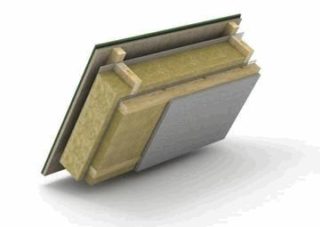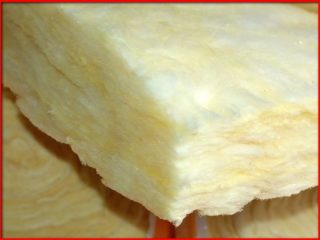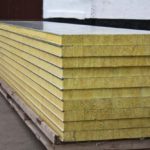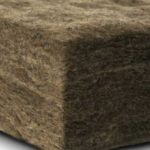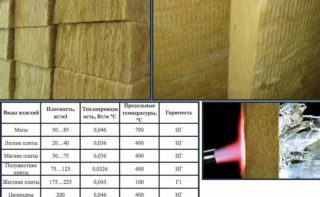Mineral wool is a fibrous insulation obtained from molten rocks and slags. It is used as heat and sound insulation. The mineral plate is cheap, lightweight, practical and effective.
Advantages over other heaters
The heat-insulating qualities of the material are due to the fibrous structure. It is different: horizontal, vertically layered, spatial, corrugated. The structure increases the heat-saving properties of the insulation and determines its advantages:
- Low thermal conductivity - 0.044 W / m * K. Minvata is slightly inferior to expanded polystyrene and polystyrene, significantly exceeds expanded clay and, especially, building materials.
- The miniplate heater does not burn and does not support fire, does not deform under the influence of high temperatures. It is used for insulation in rooms where flammable substances are stored.
- Mineral wool is resistant to any chemically aggressive substances. It is resistant to mold or mildew. Rodents also avoid it, especially glass wool.
- The material is used as an acoustic protective layer.
- Mineral wool in slabs, unlike many other heat insulators, practically does not sit.
- Installation of plates is very simple. They are easy to lay and mount on the surface.
- The material does not emit hazardous substances. It is used for thermal insulation of residential premises from the inside.
- Minvata serves up to 70 years, but this period is determined by the terms of use. If moisture penetrates the material, it quickly becomes worthless. The exception is glass wool, insensitive to moisture.
Mineral stone wool slabs are the only insulation that can be used in wooden houses. It is vapor permeable, does not accumulate moisture and prevents rotting of wood.
Main varieties
Depending on the source material used, 4 types of insulation are distinguished: glass, basalt, slag and stone wool. If their insulating properties are approximately the same, then other characteristics differ.
Glass wool
For the manufacture of using sand, dolomite waste and up to 80% of cullet. The raw materials are melted in the furnace and, using steam inflating, the finest glass filaments are obtained. Their thickness is 5-15 microns, length - 5 cm.
Glass wool is resistant to fire and water, its hygroscopicity is extremely low. Keeps properties at a temperature from -60 to +500 C. The material is resistant to vibrations.
The disadvantage is the fragility of glass fibers. In this case, the thinnest glass dust appears, irritating the mucous membrane. Work is carried out only in a respirator, goggles and protective clothing.
Stone wool
The source is rock: diabase, gabbro. Thin fibers are 5–12 μm, but their length is shorter, which is glass wool — 1.5 cm. It weakly absorbs water, and is used for covering wet rooms.
The material does not lose its quality up to +600 C. At high rates, stone wool melts. The thermal conductivity is slightly higher than that of glass wool. Its plus is crush resistance, which makes installation easier.
Cotton wool from basalt is similar in properties to stone, but blast furnace slags are not used in the production of basalt miniplates. Its thermal conductivity is lower, the cost is slightly higher.
Slag wool
It is made only from molten blast furnace slag. This is a cheap kind of insulation. Slag wool is hygroscopic, it can not be used for thermal insulation of the pipeline. It retains residual acidity; therefore, upon contact with it, the metal oxidizes. It is not suitable for warming the front door, frame buildings.
- Basalt rock stone wool
- Blast furnace slag
Specifications
Thermal conductivity and resistance to temperature are the main characteristics of the insulation. These qualities depend on the material and density.
| Views | Density, kg / m3 | Thermal conductivity, W / m * C | Temperature Limits, С | Flammability |
| Mats | 50 to 85 | 0,046 | 700 | Not combustible |
| Light plates | From 20 to 40 | 0,036 | 400 | Not combustible |
| Soft | 50 to 75 | 0,036 | 400 | Not combustible |
| Semi rigid | 75 to 125 | 0,0326 | 400 | Not combustible |
| Hard | 175 to 225 | 0,043 | 100 | 1 class |
| Cylinders | 200 | 0,046 | 400 | Not combustible |
| Loose cotton wool | 30 | 0,05 | 600 | Not combustible |
All things being equal, a semi-rigid mineral basalt slab is the most effective option.
Any structure - vertical, horizontal, inclined - is insulated with mineral wool during the construction of all types of structures. It is used to isolate industrial equipment - chemical, petrochemical, mechanical engineering, pipelines, oil and gas pipelines, tanks. The insulation is suitable for both outdoor and indoor use.
The material is included in building blocks, such as sandwich panels, reinforced concrete or three-layer concrete blocks.
Density marking
The density indicator helps to quickly determine the purpose of the product. Marking includes a letter indicating the degree of stiffness, and numbers indicate the density of the mineral wool. The following categories are distinguished:
- PM-40 and 50 - very soft, does not withstand the load. Suitable for warming frame structures.
- P-60, 70, 80 - due to the low density, the material is easily deformed, therefore it is used in lightly loaded structures: a pitched roof, pipe insulation.
- ПЖ-100, 120, 140 - mineral wool semi-rigid and rigid insulation is used for thermal insulation of walls, floors, roofs in low-rise buildings. It is part of panel structures.
- ППЖ-160, 180, 200 - withstands high loads. Suitable for insulation of flat roofs, concrete screeds, building facades.
- PT-220, 250, 300 is a rigid and solid heat insulator. They are used for finishing and insulating work in complex areas: reinforcing screeds, floor insulation.
Full labeling contains more information. It indicates the dimensions of the product, the combustibility class, the level of moisture absorption, tensile strength.
Size range of heat insulation boards
Dimensions of heat and sound insulating mineral wool plates are regulated by GOST 9573-2012. Dimensions depend on the density of the material.
| Plate | Length mm | Width mm | Thickness mm |
| PM-40.50 | 1000, 2000 | 400, 500, 600, 1000 | 30-200 |
| PP-60, 70, 80 | 1000, 2000 | 400, 500, 600, 1000 | 30-200 |
| ПЖ-100, 120, 140 | 500, 600, 1000, 2000 | 400, 500, 600, 1000 | 30-200 |
| ППЖ-160, 180, 200 | 500, 600, 1000, 2000 | 400, 500, 600, 1000 | 20-200 |
| PT-200, 250, 300 | 500, 600, 1000, 2000 | 400, 500, 600, 1000 | 20-60 |
Sizes of products at the insistence of the customer are subject to change. The plates do not increase the thickness, as this is disadvantageous.
The list of the most famous and reliable manufacturers includes the companies TechnoNIKOL, Rokvul, Knauf, Ursa, Izovol. In the ranking of the best in 2019, Rockwool takes 1st place. Of the Russian manufacturers, Technonikol is the most famous.
